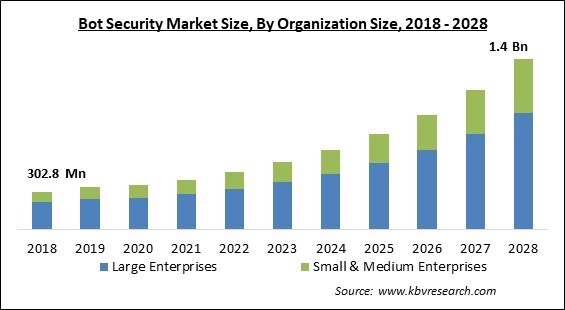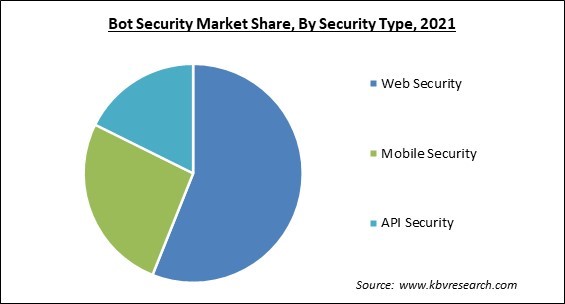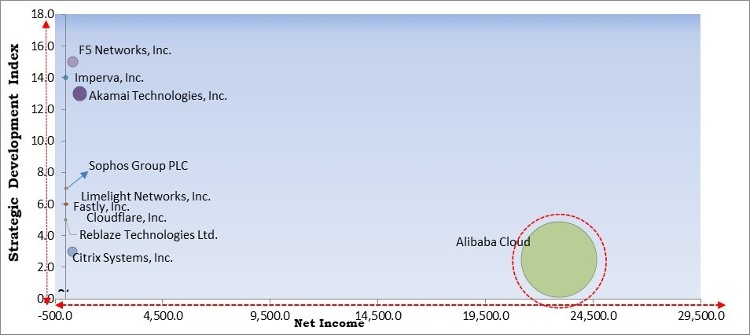The Global Bot Security Market size is expected to reach $1.4 billion by 2028, rising at a market growth of 20.0% CAGR during the forecast period.
Bots or Internet robots, often known as crawlers, spiders, and web bots, are internet-based software programs that are used to execute repetitive tasks. There are two categories of bots, namely bad bots and good bots. While good bots are useful for tasks like scanning a search engine, bad bots can be used to create a bot network and launch malware assaults. A botnet is a group of internet-connected devices that have been infected with malware and can be controlled by hackers. Botnet assaults, which include malicious actions such as password leaks, unauthorized access, data theft, and DDoS attacks, are carried out by cybercriminals using botnets. Bot security provides solutions and services for detecting botnets, blocking them, mitigating their effects, preventing botnet assaults, and keeping enterprises secure.
Bots are becoming increasingly common in critical business sectors such as financial services, retail, and travel. Credit cards, bank accounts, Social Security numbers, as well as other personal information can be collected by a bot. As a result, bots must be secure and resistant to common vulnerabilities and threats. To strengthen the security of these bots, a user can take several typical precautionary actions. Some of the Bot Framework's security mechanisms are similar to those found in other software systems, while others are unique to it.
Bots are an innovative way for a company to communicate with its customers. They can also serve as a backdoor for meddling with a company site. As a result, a business must ensure that its developers are aware of the need for bot security as part of overall website security.
End-user devices are infected with a variety of viruses with the goal of recruiting them into a botnet. Any infected device will begin interacting with a Command and Control (C&C) center and will be able to undertake automated tasks under the attacker's command. Many threat agents are actively involved in the development of gigantic botnets, the largest of which span millions of machines. The botnet can often self-replicate, for example, by sending spam emails from compromised devices, which infects new machines. Botnets are widely used for large-scale malicious behavior, such as Distributed Denial of Service (DDoS) assaults, by their owners. Botnets can also be utilized for various other malicious bot activities, like spambots or social bots, but on a much greater scale.

The COVID-19 outbreak caused a significant downfall to various economies all over the world. The outbreak of the novel coronavirus slowed down numerous businesses globally. In addition, due to the rapid spread of the infection, governments all over the world were forced to impose countrywide lockdowns. Due to the travel restrictions under the lockdown, the supply chain of various goods, as well as intermediate goods, was significantly disrupted. Moreover, the lockdown also caused a considerable hindrance to various manufacturing facilities worldwide. Due to this, world economy was majorly disrupted. Further, the internet ecosystem has become increasingly important around the world. As a result of the COVID-19 pandemic, people's reliance on internet enterprises has grown considerably, resulting in an increase in harmful bot traffic.
There is a significant number of bad bots all over the Internet. Bots accounted for a considerable proportion of all Internet traffic in recent years and over half of all the automated online traffic. In addition, the proportion of hostile botnets is estimated to grow as the popularity of assaults like credential stuffing grows due to the increasing availability of data across the dark web. Bad bots use the authorized Google bot user agent and Google Cloud Platform IP addresses to hide their actual identity and steal confidential data and information. Further, bots will account for a significant number of the entire web traffic in the coming years as they become more intelligent.
In recent years, with the increasing urbanization, the number of smartphone users all over the world is constantly increasing. This figure is also estimated to grow significantly in the next years due to increased Internet penetration. In developed and advanced economies, smartphone ownership is substantially greater in contrast to developing and under-developed countries. Smartphones are being utilized for a variety of tasks, including internet shopping, social media apps, and product research. Smartphone users are spending more time on their smartphones as a result of the introduction of social media apps like Facebook, Instagram, and Snapchat, as well as online entertainment platforms like Netflix and Amazon Prime.
Cybercrime is evolving into a profit-driven sector as a result of the use of various techniques. Cybercriminals, tool suppliers, malware operators, coders, and affiliate programs are all part of this sector, and their products, like do-it-yourself malware kits, data theft, spam-sending and launching DDoS attacks, can all be easily acquired online from a variety of sources. In numerous regions of the world, the rise of state-driven and ideological attacks that target people or organizations to support a political cause or to carry out a cyber-warfare campaign is being noted, and organizations are finding it difficult to combat these attacks.

Based on Component, the market is segmented into Standalone Solution and Services. In 2021, the service segment acquired a significant revenue share of the bot security market. The services section contains a variety of services that are essential to set up, run, and maintain a bot security platform across a company. As the bot security platform becomes more widely used, the demand for such services is estimated to rise. Bot security can be supplied by Managed Security Services analysts, who can provide remote help and incident management to clients in the event of any suspicious activity. Training and education, as well as assistance and maintenance, are examples of professional services. Bot security services provide round-the-clock protection against complex architectures, as well as SOCs staffed by security professionals and rapid incident response services.
Based on Security Type, the market is segmented into Web Security, Mobile Security, and API Security. In 2021, the web security segment registered the largest revenue share of the bot security market. The increasing growth of the segment is attributed to the rapidly growing number of web users all over the world. With the rising number of web users, the number of threats that can be following the increasing penetration of web across the world is also increasing. Therefore, the demand for web security in order to prevent these threats and cyber-attacks is significantly increasing all over the world. Due to this, the growth of the segment is estimated to augment during the coming years.
Based on Deployment Model, the market is segmented into Cloud and On-premise. In 2021, the on-premise segment recorded a significant revenue share of the bot security market. Bot management is part of a broader security plan aimed at improving consumer engagement, safeguarding digital assets, and avoiding online fraud. On-premises security refers to the policies and methods in place to safeguard the security as well as the accessibility of computer networks, which includes both hardware and software. VPNs, Firewalls, and antivirus software are a few examples, along with physical security measures. Due to the fact that on-premise deployment of bot security solutions offers complete control of these services to the consumer, the growth of this segment is estimated to increase rapidly during the forecast period.
Based on Organization size, the market is segmented into Large Enterprises and Small & Medium Enterprises. In 2021, the large enterprise segment registered the largest revenue share of the bot security market. Software robots, often known as bots, are used by large corporations to automate a wide range of business tasks, from finance and HR to customer service and manufacturing. Software bots can help firms increase business agility, while reducing costs as well as risks, and free up personnel for higher-value jobs by automating and supplementing human workflows and taking on repetitive and low-value labor. Therefore, the demand for bot security solutions is rapidly increasing and hence, the growth of this segment would expedite.
Based on Vertical, the market is segmented into Retail & E-commerce, IT & Telecom, BFSI, Government & Defense, Healthcare & Life Sciences, Travel & Tourism, Media & Entertainment, and Others. In 2021, the BFSI segment procured a significant revenue share of the bot security market. Cybercriminals target financial services companies because they are high-value targets. Malicious hackers have been able to increase the frequency of attacks on this industry in recent years due to more complex botnets as well as other bad bot attack methods. Credit card fraud, distributed denial of service attacks, account takeover attacks, and scraping content ad information from financial services websites are the most common purposes of botnets. All of these attack tactics have their own set of ramifications for the organization in question. This factor is expediting the demand for bot security services in the industry. Therefore, this factor is increasing the growth of this segment.
| Report Attribute | Details |
|---|---|
| Market size value in 2021 | USD 440.6 Million |
| Market size forecast in 2028 | USD 1.4 Billion |
| Base Year | 2021 |
| Historical Period | 2018 to 2020 |
| Forecast Period | 2022 to 2028 |
| Revenue Growth Rate | CAGR of 20% from 2022 to 2028 |
| Number of Pages | 317 |
| Number of Tables | 554 |
| Report coverage | Market Trends, Revenue Estimation and Forecast, Segmentation Analysis, Regional and Country Breakdown, Competitive Landscape, Companies Strategic Developments, Company Profiling |
| Segments covered | Component, Security Type, Deployment Model, Organization Size, Vertical, Region |
| Country scope | US, Canada, Mexico, Germany, UK, France, Russia, Spain, Italy, China, Japan, India, South Korea, Singapore, Malaysia, Brazil, Argentina, UAE, Saudi Arabia, South Africa, Nigeria |
| Growth Drivers |
|
| Restraints |
|
Based on Regions, the market is segmented into North America, Europe, Asia Pacific, and Latin America, Middle East & Africa. In 2021, North America accounted for the largest revenue share of the bot security market. The growth of the regional market is likely to be propelled by the early adoption of bot security along with the existence of a significant number of vendors offering bot security solutions. Bot security solutions are increasingly being used by organizations across this region in order to enable data security, prevent cyber-attacks on online businesses in particular, and provide data security and privacy in order to ensure business continuity. Therefore, the growth of the regional market is anticipated to flourish over the forecasting period.
Free Valuable Insights: Global Bot Security Market size to reach USD 1.4 Billion by 2028

The major strategies followed by the market participants are Product Launches. Based on the Analysis presented in the Cardinal matrix; Alibaba Cloud (Alibaba Group Holdings Limited) are the forerunners in the Bot Security Market. Companies such as F5 Networks, Inc., Imperva, Inc., Akamai Technologies, Inc. are some of the key innovators in the Market.
The market research report covers the analysis of key stake holders of the market. Key companies profiled in the report include Akamai Technologies, Inc., Imperva, Inc., Limelight Networks, Inc., Cloudflare, Inc., Citrix Systems, Inc., Fastly, Inc., F5 Networks, Inc., Sophos Group PLC, Reblaze Technologies Ltd., and Alibaba Cloud (Alibaba Group Holdings Limited).
By Component
By Security Type
By Deployment Model
By Organization size
By Vertical
By Geography
The bot security market size is projected to reach USD 1.4 billion by 2028.
A rise in the bad bot traffic are increasing are driving the market in coming years, however, increasing cases of cybercrime all over the world growth of the market.
Akamai Technologies, Inc., Imperva, Inc., Limelight Networks, Inc., Cloudflare, Inc., Citrix Systems, Inc., Fastly, Inc., F5 Networks, Inc., Sophos Group PLC, Reblaze Technologies Ltd., and Alibaba Cloud (Alibaba Group Holdings Limited).
The Standalone Solution segment dominated the Global Bot Security Market by Component in 2021; thereby, achieving a market value of $887.6 million by 2028.
The Cloud segment is leading the Global Bot Security Market by Deployment Model in 2021, and would continue to be a dominant market till 2028.
The North America is the fastest growing region in the Global Bot Security Market by Region in 2021, and would continue to be a dominant market till 2028.
Our team of dedicated experts can provide you with attractive expansion opportunities for your business.

